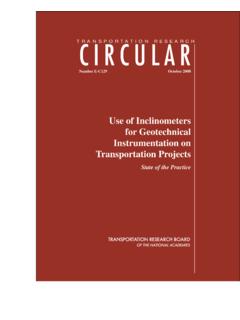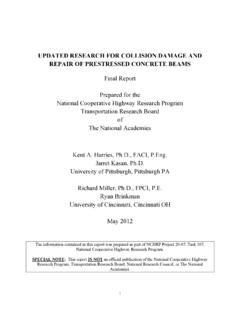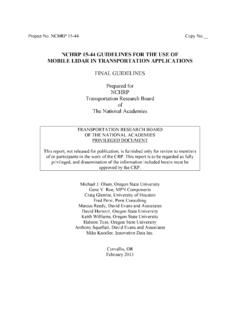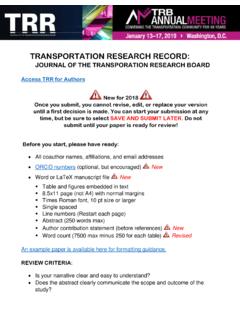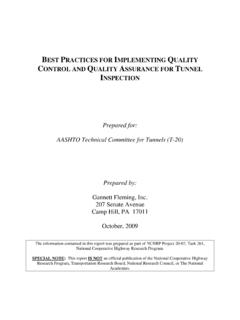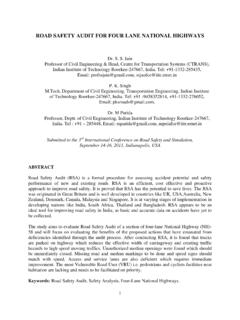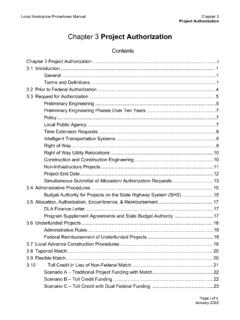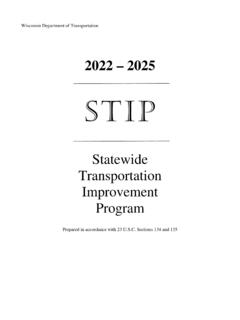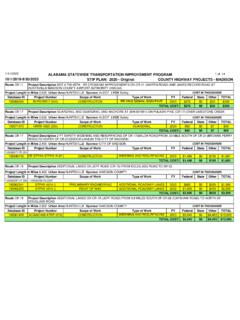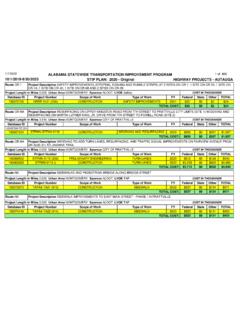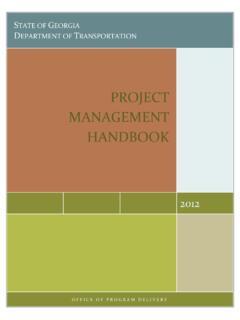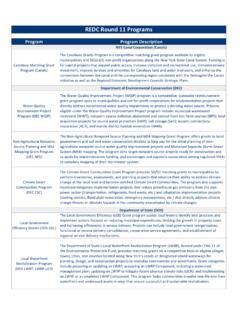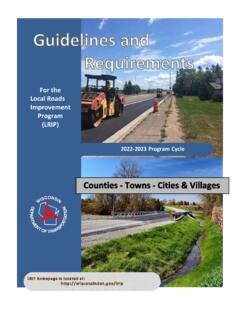Transcription of NCHRP 25-25, TASK 90 APPLICATION OF GEOGRAPHIC …
1 NCHRP 25-25, TASK 90 APPLICATION OF GEOGRAPHIC INFORMATION SYSTEMS FOR HISTORIC PROPERTIES Prepared for: AASHTO Standing Committee on the Environment Prepared by: Eric Ingbar, Gnomon, Inc. 1601 Fairview Drive, Carson City, NV 89701 and Terry H. Klein, SRI Foundation 333 Rio Rancho Drive, Suite 103, Rio Rancho, NM 87124 and Melissa Cascella, ICF International 710 Second Avenue, Suite 550, Seattle, WA 98104 September, 2015 The information contained in this report was prepared as part of NCHRP Project 25-25, Task 90, National Cooperative Highway Research Program. SPECIAL NOTE: This report IS NOT an official publication of the National Cooperative Highway Research Program, transportation Research Board, National Research Council, or The National Academies of Science, Engineering and Medicine. Acknowledgements This study was conducted for the AASHTO Standing Committee on the Environment (SCOE), with funding provided through the National Cooperative Highway Research Program ( NCHRP ) Project 25-25, Task 90 APPLICATION of GEOGRAPHIC Information Systems for Historic Properties.
2 The NCHRP is supported by annual voluntary contributions from the state Departments of transportation . Project 25-25is intended to fund quick response studies on behalf of SCOE. The report was prepared by Eric Ingbar, Principal Investigator, of Gnomon, Inc.; Terry Klein of the SRI Foundation; and Melissa Cascella of ICF International. The work was guided by a technical working group that included: Gail Anne D Avino, Georgia Department of transportation William H. Bachman, Westat David S. Clarke, Delaware Department of transportation Faisal Hameed, Parsons Corporation Elizabeth Hobbs, Minnesota Department of transportation Roy Jackson, Florida Department of transportation Bruce D. Jensen, Texas Department of transportation Erin Littauer, Washington Department of transportation MaryAnn Naber, Federal Highway Administration Liaison The project was managed by Crawford Jencks, Cooperative Research programs / NCHRP .
3 Disclaimer The opinions and conclusions expressed or implied are those of the research agency that performed the research and are not necessarily those of the transportation Research Board or its sponsoring agencies. This report has not been reviewed or accepted by the transportation Research Board Executive Committee or the Governing Board of the National Research Council. NCHRP 25-25/Task 90 APPLICATION of GEOGRAPHIC Information Systems (GIS) for Historic Properties i September 2015 EXECUTIVE SUMMARY The National Cooperative Highway Research Program ( NCHRP ) and the Federal Highway Administration (FHWA) have conducted a variety of studies on how state Departments of transportation (DOTs) streamline and enhance historic preservation compliance and project delivery, through the use of tools such as cultural resources GEOGRAPHIC Information Systems (GIS). The current NCHRP 25-25 study, Task 90 APPLICATION of GEOGRAPHIC Information Systems (GIS) for Historic Properties, is a logical extension of these previous studies, in addition to the evolution of historic preservation compliance practices within the past few years.
4 Task 90 builds upon these earlier studies by addressing the following questions: What are the time and cost benefits of using a cultural resources GIS? What are the costs (time and money) for improving and maintaining a cultural resources GIS? What are the barriers to improving and maintaining an effective GIS program? How does one overcome these barriers? What lessons have state DOTs learned from using cultural resources GIS during transportation planning and project development, especially in terms of streamlining compliance with Section 106 of the National Historic Preservation Act and Section 4(f) of the Department of transportation Act? At the start of the current project, previous studies made it clear that most state DOTs used or had access to cultural resources GIS; but, the project team was missing information on 13 states. To fill this information gap, the project team sent a survey questionnaire to the 13 states, asking if they had a cultural resources GIS, and if they did not, were they planning to develop a GIS.
5 The results of this survey, when combined with information on the other states, showed that virtually all states have a cultural resources GIS. These GIS are either maintained in-house by a state DOT, or DOT staff has access to the GIS, which is maintained by their SHPO or another state agency, such as a state university. A few states have both an in-house GIS and participate in a shared GIS. After this initial survey, the project team interviewed a sample of state DOTs, including several that participated in the initial survey. The interviews focused on the use, maintenance, and improvement of cultural resources GIS. To determine which states were to be included in this sample, the project team, in consultation with the NCHRP panel overseeing this study, considered several factors: Length of time the GIS has been used ( , the maturity of the GIS) Ways in which the GIS is used by a state DOT ( , during long range planning, analysis of projects in a State transportation improvement Plan (STIP), and/or during project development) Whether the state DOT s GIS is a shared system with other agencies ( , the SHPO) The use of special applications in GIS, such as archaeological predictive modeling If the state DOT s GIS is currently being improved NCHRP 25-25/Task 90 APPLICATION of GEOGRAPHIC Information Systems (GIS) for Historic Properties ii September 2015 DOTs were selected based upon the above factors, attempting to maximize the variation among the sampled states.
6 A total of 15 states were interviewed. When possible, the state DOT s historic preservation partners were also interviewed ( , the SHPO, a state office of archaeology, or a university that housed and maintained the cultural resources GIS). Based on previous NCHRP studies, and the results of the 15 interviews, the most common use of cultural resources GIS is as a research and screening tool, enabling users to identify the locations of recorded archaeological sites and historic built environment. These GIS are also used to assess the potential for as yet-to-be identified historic properties within a proposed project area. When accessible through a GIS, DOT staff also can identify locations in a project area that have been previously surveyed. These types of analyses are in turn used to assess the need for future cultural resources surveys, the level of effort associated with these surveys, the location of potentially significant Section 106 issues, and the location of potential Section 4(f) properties.
7 They also assist in the analysis of proposed project alternatives. These analyses are generally conducted after the initiation of the National Environmental Policy Act (NEPA) review process. A few state DOTs, however, use cultural resources GIS to conduct constraint analyses of proposed projects included in a STIP or early corridor studies, sometimes as part of long-range planning. The focus of these analyses is on the location of recorded National Register-listed and -eligible properties, as well as historic sites that may warrant protection under Section 4(f). These cultural resources GIS have become an integral part of state DOT environmental and historic preservation compliance decision making, and transportation project delivery. In addition, almost all of the interviewed state DOTs noted cost and time savings as a result of using a cultural resources GIS, especially those systems that are accessible online.
8 The state DOT interviews and those of their historic preservation partners, also revealed that almost all of the states are moving, or would like to move, toward the same goal. This goal is to have a single, statewide cultural resources GIS (SCRGIS) maintained by a single entity. Based on the interviews, this GIS would: Be housed and maintained by a state university, the DOT, the SHPO, or other entity Be accessible online with appropriate security measures Have multiple levels of access ( , the public; DOT cultural resources staff, environmental staff, designers, and project managers; local transportation agencies; cultural resources professionals outside the DOT; and tribes) Contain all recorded cultural resources locations and boundaries ( , archaeological sites, historic built environment, and historic districts) Show boundaries of all surveyed/ inventoried areas Contain Section 106 correspondence and associated documents from the SHPO, the state DOT, and other state and federal agencies Have all associated reports, property/site forms, and records Allow multiple contributors to upload data into the GIS Allow users to download data and use these data for conducting agency-specific analyses, and producing agency maps and reports NCHRP 25-25/Task 90 APPLICATION of GEOGRAPHIC Information Systems (GIS) for Historic Properties iii September 2015 The project team, in consultation with the NCHRP panel, prepared a road map for implementing a single, SCRGIS.
9 This road map examines the steps to develop the GIS, the partnerships required in building the GIS, and how to overcome the barriers that will be encountered. This road map relies on the findings of earlier NCHRP and FHWA studies, and on the interviews conducted under the current NCHRP project. The final element of the NCHRP 25-25/Task 90 study is a discussion on mechanisms for promoting and implementing these types of GIS nationwide. NCHRP 25-25/Task 90 APPLICATION of GEOGRAPHIC Information Systems (GIS) for Historic Properties iv September 2015 TABLE OF CONTENTS Page Executive Summary ..i Project Goals and Methods .. 1 Introduction ..1 What is a GIS? ..2 Study Approach ..3 Business Case for Having a cultural resources GIS .. 6 Common Uses ..6 Benefits and Effectiveness of GIS Use ..8 The Goal: A Single, statewide cultural resources GIS .. 14 What Does this GIS Look Like?
10 14 Common Issues to 16 How Do You Get There? .. 18 Design Steps .. 18 Recommended Partnerships .. 27 How Do You Pay for It? .. 27 Tiered Approaches to Creating a statewide Cultural Resource GIS .. 29 Recommendations for Future Actions .. 31 References Cited .. 34 Appendices A. Interview Questionnaire B. Examples of Current State cultural resources GIS NCHRP 25-25/Task 90, APPLICATION of GEOGRAPHIC Information Systems (GIS) for Historic Properties 1 September 2015 PROJECT GOALS AND METHODS INTRODUCTION The past five years of historic preservation practice have seen a marked increase in the use of cultural resources GEOGRAPHIC Information Systems (GIS) among state Departments of transportation (DOTs), other state and federal agencies, and the private sector. Cultural resources include archaeological sites, the historic built environment, and properties of religious and cultural significance to tribes and Native Hawaiians.

